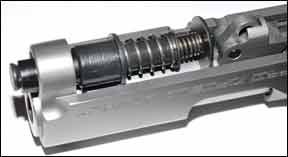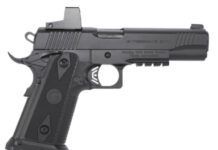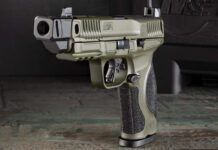A couple of months ago, a third gun showed up as we were wrapping up our test of two carry 9mm Lugers, the SIG P239 and H&K’s USP Compact. This was the Springfield EMP, which has a stunning MSRP of $1345. This pistol was a little smaller than the other two, and had a very simple and familiar mechanism. It was basically a small 1911 built around the 9mm cartridge. The barrel was 3.2 inches. The side of the slide was marked with a logo of the letters EMP done in a manner that left the sides of the letters off. While that was clever, we wondered what else had been left off of this small nine that maybe ought to have been there. Frankly, boys and girls, for that price there better be exactly nothing left off.

The first things we noticed were the very bright tritium sights mounted in fixed bases that gave an excellent sight picture. The sights were dovetailed into the slide very well, the front contoured to match the top of the slide. The edges of the ejection port were broken to avoid cut hands. So was the front of the slide to ease holster entry, though it could have been beveled more, we thought. The slide was matte stainless and the aluminum frame was matte black. There was a good beavertail and ambi safeties. The skeleton hammer gave promise of fast lock time. The grip panels were checkered wood with Springfield’s logo on both sides, but the grips didn’t even come close to matching colors side to side. The trigger was a Videki style. The magazine was made in Italy by Mec-Gar, which makes good magazines, though there were no holes to tell how many rounds were loaded into it. We think it needs them. The mag held nine cartridges in a single stack. The grip was big enough that we could get all our fingers onto the little gun, and the mag extension made the grip a touch bigger for fatter fingers.
There was no barrel bushing at the front. The barrel was fitted directly to the slide. This was cleverly done by means of starting off with a thick-walled tube for the barrel, fitting it at the front to the slide, and then cutting it away to form the locking lugs on its top. Before going to the range we took a look inside. Takedown was similar to that required for a 1911, except you don’t have to mess with the barrel bushing. The first time we took it down we had not read the specific disassembly instructions, and ran into a real snag. This got us very angry at the little gun. If you don’t know the trick, or don’t have the tiny plastic collar that’s vital to the takedown, you’ll fail here. Read the book!
The correct way to take it apart is to first lock back the slide of the unloaded gun and then jam that little piece of plastic onto the recoil-spring guide under the muzzle. If you don’t have the plastic piece, we advise against field stripping it. If you lose that takedown collar, which you will surely do, you’ll need a replacement. We suggest getting a dozen of them, just to be sure you can get the gun back together in the future. Yes, you can get it apart, but if you don’t have that plastic piece you may have to resort to a hammer to reassemble the gun. In case you haven’t guessed, we don’t like this system at all for a gun that might be taken and used seriously afield.
By the way, our gun arrived absolutely swimming in preservative oil. We recommend a disassembly and wiping out of at least 90 percent of all that, or even better, take out 100 percent of it and re-lube it with your favorite gun oil. We did that, using a trace of Slide-Glide and some of Bushmaster’s Lubricant & Protectant, which you used to know as the unobtainable Smith & Wesson Premium Lubricant & Protectant.
With the bit of takedown plastic in place, release the slide gently and then push the crosspin out, lining up the notch in the slide just like for a 45 auto 1911. Then the slide comes off, the now-jammed recoil spring assembly with its bushing and the takedown collar comes out. Take the barrel out the front. Don’t lift it. It won’t come out the back. Everything looked very good inside. The frame was straight 1911, no surprises there. One feature of the gun some of us applauded was its lack of all the machinery associated with firing-pin locks. Reassembly was an easy reversal of the takedown process, with no hitches along the way, though we’d have liked to see a new crosspin design that would avoid the ancient problem of the 1911, getting the crosspin past both the spring plunger and the slide notch easily. The mag well was nicely beveled for easier entry of the magazines. The trigger was okay, if a bit stiff, at 5 pounds.

About the only other thing we noted was a great reluctance for the magazines to get past the magazine catch. It took a mighty hard push. We took out the catch to see what the trouble was and found it had a very stiff spring. Maybe some polishing and use would slick it up. We also didn’t like the absolute lack of traction on the front of the grip strap. We at first thought it needed checkering, stippling, or something there. The rear strap had the usual checkered mainspring housing. We found it easy to depress the grip safety with anything approaching a normal firing grip.
On the range, the EMP did not really distinguish itself. Accuracy was not great, around 3 inches at 15 yards with the ammo tried. Maybe more shooting and/or different bullet weights would improve it. We had only 115-grain loads on hand. We did see some tight clusters of four shots every now and then, so the accuracy might improve. However, we thought the gun had adequate accuracy for self defense as it was. The sights were excellent and the gun shot to them well enough, we thought. The gun felt great to those of us who like the 1911s, though it lacked the power of a 40 or 45. The lack of traction on the front strap turned out to not be an issue. There were no problems with the gun’s function at all.
Our Team Said: We’d like to see an additional inch of slide and barrel, along with doing away with that nonsensical takedown collar. After all, this is not a pocket gun, and some extra barrel length would be just as easy to carry and conceal as this one is, and the extra barrel would get more out of the 9mm Luger, too. We’d also like to see press-check serrations on the front of the slide, and some checkering on the front strap. We hated the takedown collar system, but if you can live with that, this is a decent little gun, quite well made in fact. But $1345? We think that’s really on the too-steep side. We gave it an A because it did what it was supposed to and followed its design, but we’d prefer to give it a C for that high price and its highly questionable takedown system.
Written and photographed by Ray Ordorica, using evaluations from Gun Tests team testers.




























Truly an investment more than a everyday carry pistol. Beautifully designed with all the best features of a 1911 in a pistol that was not a rethroated 45. Great balance and handles well. My Springfield EMP4 has the 4 inch barrel and is offered in 9mm and 40 caliber. To be honest it has a bit of weight to have tucked in your waist but no heavier than my Ruger Commander. The Burk Parks special holster fits it well. The pistol is checkered on the back strap and the front grip. It’s a joy to shoot, it comes with a target barrel and fiber optic sights. I carry it on the boat, but for everyday carry I purchased 2 Taurus 3Gc pistols. I just can’t see the Springfield for everyday use. Who in his right mind would carry a trophy gun to go shopping and do daily chores. It’s a beautiful piece of engineering and I don’t want to pick up the nicks and wear marks from daily wear. The Taurus is much lighter and has no frailties. Just what you need to protect and serve.